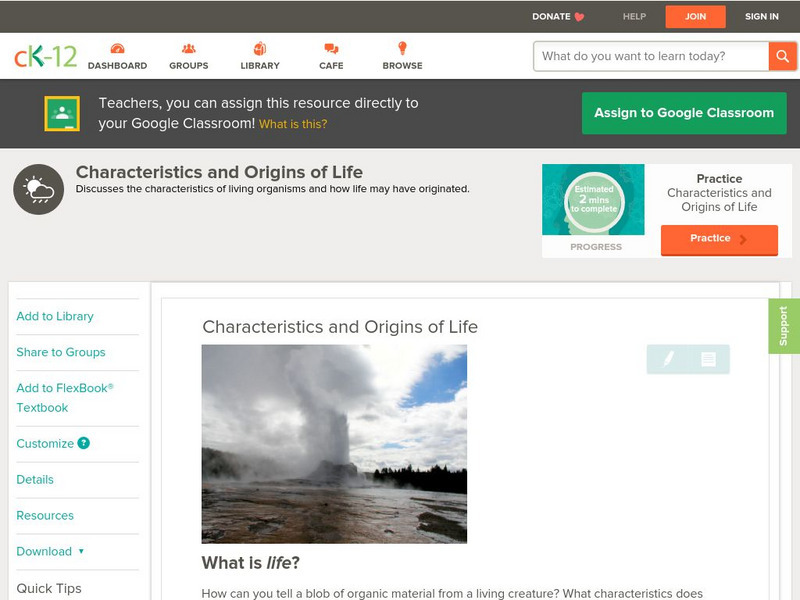BioEd Online
Bio Ed Online: The Science of Microbes: Making Copies of an Hiv Particle
Learners read an article about how the HIV virus replicates itself in a host cell, and the parts of an HIV particle. Includes labeled drawings of an HIV particle and of its replication cycle. The lesson plan materials and a set of...
BioEd Online
Bio Ed Online: The Science of Microbes: Mapping the Spread of Hiv/aids
After reading an article about how the spread of HIV/AIDS was first tracked, students act as epidemiologists to map its spread round the world. The lesson materials and a set of PowerPoint slides can be downloaded.
Biology 4 kids
Biology4 Kids: Man and Microbes
Biotechnology has been studied for some time. This science has led to medical vaccinations and antibiotics, microbes in warfare, and cleaning up the environment.
University of Missouri
Microbes in Action: Classroom Activities: Simple Staining of Microbes [Pdf]
With this simple stain, students can observe the shape of yeast and bacteria under the microscope. Lesson plan gives a lab procedure, teacher instructions, points for discussion, and additional activities. Lab does require the purchase...
University of Missouri
Microbes in Action: Classroom Activities: Water Quality Testing [Pdf]
In this experiment, students will test the quality of a water sample by observing the number of coliform bacteria. Coliform bacteria are found in human intestines and a large amount can indicate water contamination. Lesson plan gives a...
University of Missouri
Microbes in Action: Classroom Activities: A Swell Lab: Yeast Fermentation [Pdf]
This two-day experiment uses different concentrations of sugar to study the rate of fermentation. Students observe the rate of carbon dioxide gas produced by yeast to infer the rate of fermentation. Lesson plan gives a lab procedure,...
University of Missouri
Microbes in Action: "There's Something Fishy": The Nitrogen Cycle
An opportunity for students to experience the nitrogen cycle through observing daily changes in an aquarium. Students test the level of three nitrogen compounds to understand the process of nitrification. Lesson plan gives a lab...
CK-12 Foundation
Ck 12: Earth Science: Characteristics and Origins of Life
[Free Registration/Login may be required to access all resource tools.] Describes characteristics of living organisms, and the origin of life.
CK-12 Foundation
Ck 12: Earth Science: Characteristics and Origins of Life
[Free Registration/Login may be required to access all resource tools.] Describes characteristics of living organisms and the origin of life.
Biotechnology Institute
Biotechnology Institute: Your World: A World of Change [Pdf]
The introduction of genetically modified organisms (animals, microbes, and plants) into agriculture has been accompanied by controversies over their potential impact on human health, the environment, and farming systems. Management of...
City University of New York
Brooklyn College: Direct Microscopic Counts
Guidelines for an activity through which you, acting as a research assistant for a wine merchant, work to grow a microbe under different conditions.
University of Missouri
Umsl: Microbes in Action: Cultivation of Bacteria From Yogurt [Pdf]
Observe the two species of bacteria that are found in yogurt by cultivating them on agar plates. In this lab, students will use microbiology techniques to explore these anaerobes. Lesson plan gives a lab procedure, teacher instructions,...
My Hero Project
My Hero: Louis Pasteur
Use this site to learn about Louis Pasteur's contributions to the world of science and to lives of ordinary people. View the "related links" as well as the bibliographical references from which images for the website were scanned.
PBS
Pbs Teachers: Mysteries of the Universe
Consider the issues surrounding the world of space exploration including the new fields of archaeoastronomy and astrobiology. Investigate zero gravity, the Big Bang theory, life in space and how sound travels in a vacuum.
Other
Tea: Some Like It Hot, Some Like It Cold Microbial Life
A science lab to determine the optimal temperature for common bacteria to grow. Students will graph their data to analyze and focus on bacteria that live in extreme conditions. To complete this experiment students will perform a gram stain.
Georgia Department of Education
Ga Virtual Learning: Epidemiology, Public Health, and You
Activities in this comprehensive interactive tutorial will help you explore various public health careers. In addition, you will learn about why ethical guidelines are necessary in epidemiological research; emerging and past public...



![Microbes in Action: Classroom Activities: Simple Staining of Microbes [Pdf] Activity Microbes in Action: Classroom Activities: Simple Staining of Microbes [Pdf] Activity](https://d15y2dacu3jp90.cloudfront.net/images/attachment_defaults/resource/large/FPO-knovation.png)





